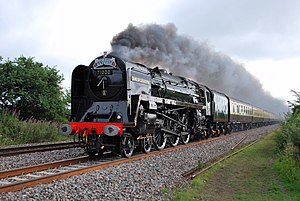| BR Standard Class 8[1] | |||||||||||||||||||||||||||||||||||||||||||||||||||||||||||||||||
|---|---|---|---|---|---|---|---|---|---|---|---|---|---|---|---|---|---|---|---|---|---|---|---|---|---|---|---|---|---|---|---|---|---|---|---|---|---|---|---|---|---|---|---|---|---|---|---|---|---|---|---|---|---|---|---|---|---|---|---|---|---|---|---|---|---|
 The sole Standard Class 8 crossing the Somerset Levels | |||||||||||||||||||||||||||||||||||||||||||||||||||||||||||||||||
| |||||||||||||||||||||||||||||||||||||||||||||||||||||||||||||||||
| |||||||||||||||||||||||||||||||||||||||||||||||||||||||||||||||||
| |||||||||||||||||||||||||||||||||||||||||||||||||||||||||||||||||
| |||||||||||||||||||||||||||||||||||||||||||||||||||||||||||||||||
The BR Standard Class 8 was a class of a single 4-6-2 Pacific steam locomotive designed by Robert Riddles for use by British Railways. Only the prototype was constructed, which was christened the name Duke of Gloucester. Constructed at Crewe Works in 1954, the Duke, as it is popularly known, was a replacement for the destroyed LMS Princess Royal Class locomotive number 46202 Princess Anne, which was involved in the Harrow and Wealdstone rail crash of 1952.[2]
The Duke was based on the BR Standard Class 7 Britannia design. It incorporated three sets of modified Caprotti valve gear, relatively new to British locomotive engineering and more efficient than Walschaerts or Stephenson valve gear. The Duke was regarded as a failure by locomotive crews due to its poor steaming characteristics and its heavy fuel consumption. Trials undertaken by British Railways also returned negative feedback, reporting problems with the poor draughting of the locomotive which resulted in difficulty adhering to the timetables.
The result was an operational period of only eight years. This unique locomotive was saved from being scrapped at Woodham Brothers scrapyard in Barry, Vale of Glamorgan, South Wales when it was purchased by a group of railway enthusiasts who restored it from scrapyard to as-built condition in 13 years. Since then, modifications have been made to the original design, resulting in one of the most efficient and powerful steam locomotives ever to run in Britain.[3] As a result, the Duke of Gloucester could frequently be seen on the mainline around Britain. As of 2024, the locomotive is being overhauled to return it to operational condition.
- ^ Cite error: The named reference
Herringwas invoked but never defined (see the help page). - ^ Cite error: The named reference
Langstonwas invoked but never defined (see the help page). - ^ "The changes of the locomotive's characteristics". The Duke of Gloucester Locomotive Trust. Retrieved 30 August 2007.
